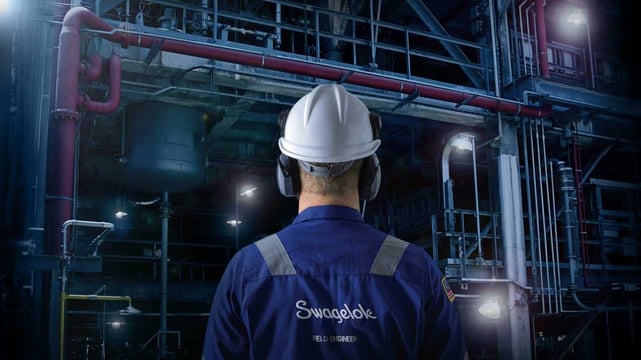Share this
Preventing High Temperature Hydrogen Attack Through Improved Instrumentation Tubing Metallurgy
by Morgan Zealear on 11/2/22 9:00 AM

Instrumentation tubing in oil and gas refineries and petrochemical facilities is based on the process conditions and the nature of the fluid in direct contact. Usually, these conditions comprise chemical components being processed under high temperatures and pressure. Based on these conditions, the selection of the right instrumentation is necessary for the safe operation of pressure switches, gauges, and valves within the facility's fluid system.
A major problem these industrial plants face under such extreme conditions is high temperature hydrogen attack. One way to minimize this issue is by using tubing and valves from high-grade metal.
High Temperature Hydrogen Attack in Instrumentation Tubing
High temperature hydrogen attack (HTHA) occurs when the carbon steel tubing operating at high temperatures, usually above 400°F, is exposed to hydrogen. A typical petrochemical refinery or thermal power plant may operate at temperatures as high as 1000°C. When carbon steel tubing is exposed to hydrogen at this temperature, the hydrogen molecules within the process fluid dissociate and react with the carbon. The hydrogen can easily attack at the points where there is a prominence of flaws such as grain boundaries or imperfections in the crystal structure. As a result, the following effects may occur:
- Surface decarburization: Degradation of the surface caused by a decrease in hardness and loss of strength at the surface (carbon removal)
- Internal decarburization: Hydrogen and carbon react to form methane which accumulates within the metal to form micro fissures and voids (carbon reformation)
HTHA can be especially damaging for welded tubing with cracks developing faster, deeper, and concentrating along the fusion interface and heat-affected zone.
With the loss of strength and formation of fissures and cracks, the defective tubing is sure to be the major cause of failure. Moreover, the microscopic nature of the defect makes it difficult to detect and requires specialized inspection, i.e., non-destructive testing, so the mitigation measure can be acted upon quickly.
The ideal way of managing HTHA in instrumentation is to replace the use of traditional carbon steel with high-grade metals. Alloying the carbon steel with elements such as Chromium, Inconel®, and Molybdenum can stabilize the carbides to improve the resistance of the metal against HTHA.
High-Quality Components Reduces Failure Due to High Temperature Hydrogen Attack
When selecting tubing and associated components for your facility's instrumentation system, there are a few things to keep in mind—process condition, mechanical properties, and material compatibility. Depending on the metallurgical properties desired at the elevated pressure and temperature range, the material should be compatible with handling the media content, especially if it is corrosive in nature. For HTHA prevention, the steel used should be highly alloyed with metals that can improve the stability of the carbide in the steel and improve its corrosion resistance.
Swagelok's tubing made of 304 or 316 stainless steel adhere to the ASTM standards and provides better resistance against corrosion and HTHA. 304 stainless steel has a high chromium content (18-20%) and nickel content (8-10%) while 316 stainless steel is composed of chromium (16-18%), molybdenum (2-3%), and nickel (10-14%) in considerable amounts. These compositions are suitable to counter the attack of hydrogen on steel to a certain degree.
In hydrogen-rich applications, it is also important to make sure the supporting components are of high-quality, so the system doesn’t fail. High-grade metal valves such as the high-chrome, high-molybdenum valves support the instrumentations’ resistance against hydrogen diffusion and HTHA.
Select the Right Instrumentation Tubing Metallurgy With Swagelok
Swagelok’s tubing and tubing accessories can handle the high-temperature and pressure conditions to offer you a safe and reliable operation. The 304/316 stainless steel composition makes the instrumentation tubing resilient to hydrogen attacks. To ensure all the components of the instrumentation system works in unison, Swagelok also offers high-temperature valves such as the 60 series. With all the components capable of resisting high-temperature and corrosive attacks, your tubing system is sure to be even safer.
Before you start the selection of your instrumentation tubing, you may want to consult with experts specializing in fluid systems. You can leverage Swagelok’s Onsite Engineering Services for a thorough analysis of your system and get recommendations regarding the right tubing and accessories for your system that can reduce the risk of high temperature hydrogen attack.
Take advantage of Swagelok’s expertise and high-quality components to improve the safety and efficiency of the instrumentation at your facility.
To find out more about the role of Swagelok Northern California’s onsite engineering services and instrumentation tubing in minimizing the risk of high temperature hydrogen attack at your facility, contact our team today by calling 510-933-6200.
 Morgan Zealear | Product Engineer – Assembly Services
Morgan Zealear | Product Engineer – Assembly Services
Morgan holds a B.S. in Mechanical Engineering from the University of California at Santa Barbara. He is certified in Section IX, Grab Sample Panel Configuration, and Mechanical Efficiency Program Specification (API 682). He is also well-versed in B31.3 Process Piping Code. Before joining Swagelok Northern California, he was a Manufacturing Engineer at Sierra Instruments, primarily focused on capillary thermal meters for the semiconductor industry (ASML).
Share this
- Archive (465)
- Assembly Services (207)
- About (100)
- Seal Support Systems (96)
- Best Practices (88)
- Training Services (74)
- Fittings (51)
- Semiconductor Applications (49)
- Hoses and Flexible Tubing (47)
- Regulators (44)
- Tubing (42)
- Grab Sampling Systems (32)
- Sampling Systems (32)
- Gas Systems (30)
- Services (30)
- Downloads (29)
- Valves (24)
- Application Support (18)
- Orbital Welding (17)
- Case Studies (13)
- Steam Systems (13)
- Frequently Asked Questions (12)
- Tools (12)
- Measurement Devices (7)
- Subsystems (6)
- Thermal Management (6)
- September 2023 (1)
- August 2023 (2)
- June 2023 (1)
- March 2023 (3)
- February 2023 (3)
- January 2023 (4)
- December 2022 (4)
- November 2022 (4)
- October 2022 (4)
- September 2022 (1)
- August 2022 (3)
- July 2022 (2)
- June 2022 (4)
- May 2022 (1)
- April 2022 (2)
- March 2022 (1)
- February 2022 (2)
- January 2022 (3)
- December 2021 (1)
- November 2021 (6)
- October 2021 (6)
- September 2021 (8)
- August 2021 (4)
- July 2021 (3)
- June 2021 (6)
- May 2021 (6)
- April 2021 (7)
- March 2021 (5)
- February 2021 (4)
- January 2021 (6)
- December 2020 (5)
- November 2020 (6)
- October 2020 (6)
- September 2020 (8)
- August 2020 (7)
- July 2020 (8)
- June 2020 (8)
- May 2020 (6)
- April 2020 (9)
- March 2020 (7)
- February 2020 (10)
- January 2020 (21)
- December 2019 (23)
- November 2019 (21)
- October 2019 (22)
- September 2019 (21)
- August 2019 (22)
- July 2019 (23)
- June 2019 (20)
- May 2019 (23)
- April 2019 (22)
- March 2019 (21)
- February 2019 (20)
- January 2019 (21)
- December 2018 (14)
- November 2018 (19)
- October 2018 (23)
- September 2018 (17)
- August 2018 (29)
- July 2018 (11)
- June 2018 (6)
- May 2018 (5)
- April 2018 (4)
- March 2018 (5)
- February 2018 (3)
- January 2018 (3)
- December 2017 (2)
- November 2017 (4)
- October 2017 (3)
- September 2017 (2)
- August 2017 (6)
- July 2017 (4)
- June 2017 (4)
- May 2017 (4)
- April 2017 (3)
- March 2017 (4)
- February 2017 (3)
- January 2017 (3)
- December 2016 (3)
- November 2016 (3)
- October 2016 (3)
- September 2016 (5)
- August 2016 (5)
- July 2016 (4)
- June 2016 (5)
- May 2016 (3)
- April 2016 (4)
- March 2016 (5)
- February 2016 (11)
- January 2016 (1)
- December 2015 (3)
- November 2015 (4)
- October 2015 (3)
- September 2015 (4)
- August 2015 (4)
- July 2015 (8)
- June 2015 (5)
- May 2015 (3)
- April 2015 (4)
- March 2015 (4)
- February 2015 (3)
- January 2015 (4)
- December 2014 (2)
- November 2014 (3)
- October 2014 (4)
- September 2014 (4)
- August 2014 (4)
- July 2014 (5)
- June 2014 (4)
- May 2014 (4)
- April 2014 (5)
- March 2014 (4)
- February 2014 (3)
- January 2014 (4)
- December 2013 (5)
- November 2013 (3)
- October 2013 (4)
- September 2013 (3)
- August 2013 (5)
- July 2013 (5)
- June 2013 (5)
- May 2013 (3)
- April 2013 (6)
- March 2013 (4)
- February 2013 (4)
- January 2013 (8)
- December 2012 (4)
- November 2012 (6)
- October 2012 (6)
- September 2012 (4)
- August 2012 (4)
- July 2012 (4)
- June 2012 (4)

.webp?width=210&height=70&name=StickyLogo%20(5).webp)